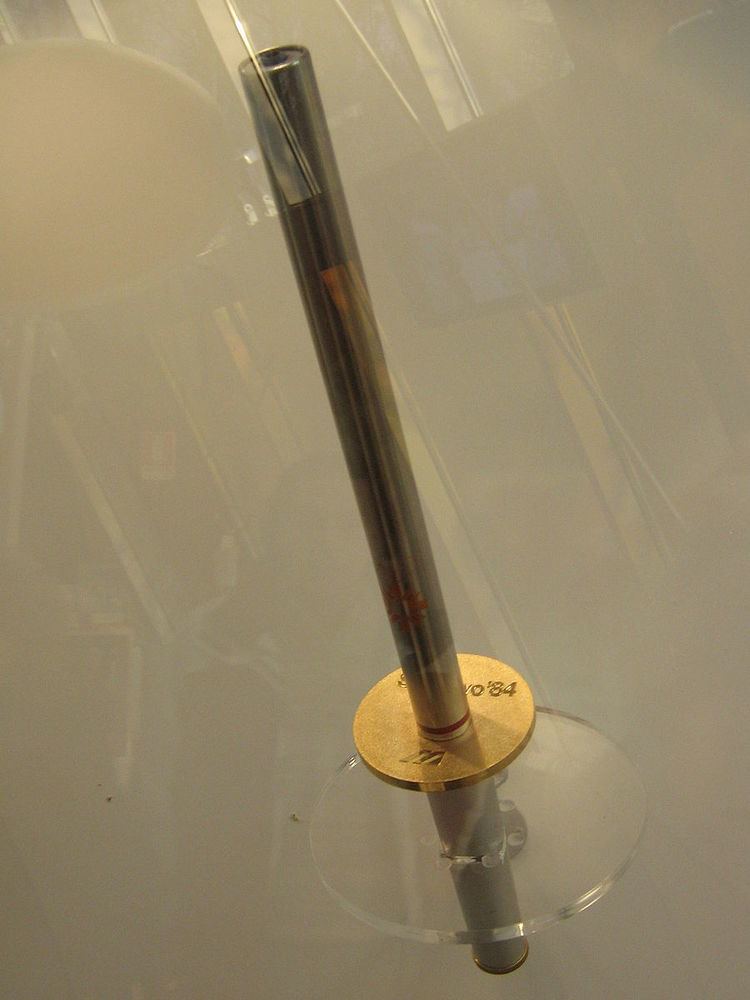Host city Sarajevo, Yugoslavia Opening ceremony 8 February | Nations participating 49 Closing ceremony 19 February | |
 | ||
Athletes participating 1272
(998 men, 274 women) Events 39 in 6 sports (10 disciplines) | ||
The 1984 Winter Olympics, officially known as the XIV Olympic Winter Games (French: Les XIVes Jeux olympiques d'hiver; Serbo-Croatian: XIV zimske olimpijske igre / XIV Зимске олимпијске игре; Macedonian: XIV Зимски олимписки игри), was a winter multi-sport event which took place from 8–19 February 1984 in Sarajevo, Bosnia-Herzegovina, Yugoslavia. Other candidate cities were Sapporo, Japan; and Gothenburg, Sweden.
Contents
- Host city selection
- Torch relay
- Highlights
- Official mascot
- City venues
- Mountain venues
- Other facilities
- Competitive events
- Demonstration sport
- Calendar
- Participants
- References
It was the first Winter Olympics held in a Communist state. It was also the second Olympics overall, as well as the second consecutive Olympics, to be held in a Communist nation after the 1980 Summer Olympics were held in Moscow, Soviet Union. The only other games that have since been held in a communist state are the 2008 Summer Olympics held in Beijing and 2014 Summer Youth Olympics in Nanjing, and the 2022 Winter Olympics which will be held in Beijing. All of these have been in China.
Host city selection
The host city for the XIV Winter Olympics was announced on 18 May 1978 during an 80th session of the International Olympic Committee in Athens, Greece. Sarajevo was selected over Sapporo, Japan (which hosted the games 12 years earlier) by a margin of three votes. Gothenburg was the first city in Sweden to lose a Winter Olympic bid, as other Swedish cities such as Falun and Östersund would later lose their consecutive bids to Calgary, Albertville, Lillehammer, Nagano, and Salt Lake City respectively. Sarajevo, capital of Bosnia and Herzegovina, was part of the united Yugoslavia at the time.
Torch relay
The torch relay for the 1984 Sarajevo Olympic games started in Olympia and then proceeded by airplane to Dubrovnik. The total distance of the torch relay through Yugoslavia was 5,289 kilometres (3,286 mi) (plus 2,879 kilometres (1,789 mi) of local routes). There were two main routes – one in the west (Split – Ljubljana – Zagreb – Sarajevo with 2,602 kilometres (1,617 mi) of length) and the other in the east (Skopje – Novi Sad – Belgrade – Sarajevo with 2,687 kilometres (1,670 mi) of length). The final torchbearer, from a total of 1600, was figure skater Sanda Dubravčić, who received the torch from skier runner Ivo Čarman. Today one of the two original torches is in Slovenia in a private collection in Žalec, Slovenia. Also 20 more torches are in Greece owned by individual athletes, who were the torchbearers from Ancient Olympia to the nearby military airport and from Athens Domestic Airport to the Panathinaikon Stadium where the Ceremony of handing over the Olympic Flame to the Sarajevo Olympic Games Committee occurred.
Highlights
Official mascot
Readers of Yugoslav newspapers were asked to choose the mascot for the 1984 Winter Olympics from a list of six finalists. The winner was Vučko, the little wolf, designed by Slovenian designer and illustrator Jože Trobec. The other finalists were a chipmunk, a lamb, a mountain goat, a porcupine, and a snowball. The Vučko is a long-time symbol of Sarajevo.
City venues
Mountain venues
Other facilities
Competitive events
There were 39 events contested in 6 sports (10 disciplines).
Demonstration sport
Calendar
All dates are in Central European Time (UTC+1)Participants
A then record of 49 National Olympic Committees (NOCs) entered athletes at the 1984 Winter Olympic Games.
Egypt, Monaco, Puerto Rico, Senegal, and the British Virgin Islands participated in their 1st Winter Olympic Games.
The People's Republic of China ended its boycott of the Olympic Games over the controversy regarding the IOC's recognition of the Republic of China. The Republic of China (Taiwan) then competed as Chinese Taipei for the first time.
Many smaller countries competed in these games, due to the funding program created by the IOC. The IOC decided that it would cover all expenses for one male and one female athlete, per country. This allowed countries with smaller athletic budgets to participate in the Games.
